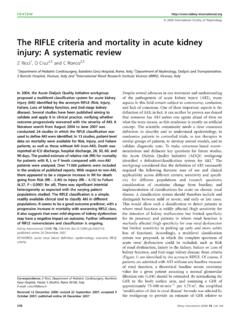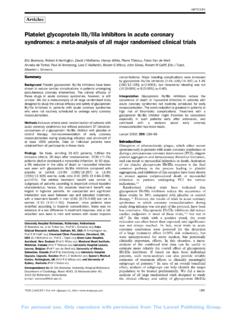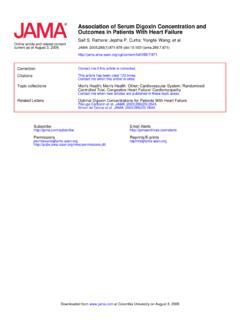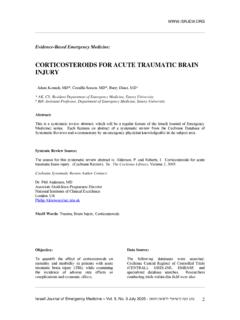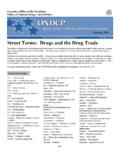Transcription of Oral or IV Prednisolone in the Treatment of
1 Oral or IV Prednisolone in the Treatment of COPD Exacerbations *. Ynze P. de Jong, Steven M. Uil, Hans P. Grotjohan, Dirkje S. Postma, Huib Kerstjens and Jan van den Berg Chest 2007;132;1741-1747; Prepublished online July 23, 2007;. DOI The online version of this article, along with updated information and services can be found online on the World Wide Web at: CHEST is the official journal of the American College of Chest Physicians. It has been published monthly since 1935. Copyright 2007. by the American College of Chest Physicians, 3300 Dundee Road, Northbrook IL 60062. All rights reserved. No part of this article or PDF. may be reproduced or distributed without the prior written permission of the copyright holder. ( ) ISSN:0012-3692. Downloaded from at Columbia University on August 3, 2009. Copyright 2007 American College of Chest Physicians Original Research COPD.
2 Oral or IV Prednisolone in the Treatment of COPD Exacerbations*. A Randomized, Controlled, Double-blind Study Ynze P. de Jong, MD; Steven M. Uil, MSc; Hans P. Grotjohan, MD, PhD;. Dirkje S. Postma, MD, PhD; Huib Kerstjens, MD, PhD; and Jan van den Berg, MD, PhD, FCCP. Background: Treatment with systemic corticosteroids for exacerbations of COPD results in improvement in clinical outcomes. On hospitalization, corticosteroids are generally administered IV. It has not been established whether oral administration is equally effective. We conducted a study to demonstrate that therapy with oral Prednisolone was not inferior to therapy with IV. Prednisolone using a double-blind, double-dummy design. Methods: Patients hospitalized for an exacerbation of COPD were randomized to receive 5 days of therapy with Prednisolone , 60 mg IV or orally. Treatment failure, the primary outcome, was defined as death, admission to the ICU, readmission to the ICU because of COPD, or the intensification of pharmacologic therapy during a 90-day follow-up period.
3 Results: A total of 435 patients were referred for a COPD exacerbation warranting hospitaliza- tion; 107 patients were randomized to receive IV therapy, and 103 to receive oral therapy. Overall Treatment failure within 90 days was similar, as follows: IV Prednisolone , ; oral Prednisolone , (one-sided lower bound of the 95% confidence interval [CI], ). There were also no differences in early (ie, within 2 weeks) Treatment failure ( and , respectively; one-sided lower bound of the 95% CI, ), late (ie, after 2 weeks) Treatment failure ( and , respectively; one-sided lower bound of the 95% CI, ), and mean ( SD) length of hospital stay ( and days, respectively). Over 1 week, clinically relevant improvements were found in spirometry and health-related quality of life, without significant differences between the two Treatment groups. Conclusion: Therapy with oral Prednisolone is not inferior to IV Treatment in the first 90 days after starting therapy.
4 We suggest that the oral route is preferable in the Treatment of COPD. exacerbations. Trial registration: Identifier: NCT00311961. (CHEST 2007; 132:1741 1747). Key words: COPD; exacerbation; IV Prednisolone ; oral Prednisolone Abbreviations: CCQ Clinical COPD Questionnaire; CI confidence interval; GOLD Global Initiative for Chronic Obstructive Lung Disease; MCID minimal clinically important difference; SGRQ St. George Respiratory Questionnaire C OPD is a major health problem worldwide, and both morbidity and mortality are rising. Char- 1. been demonstrated to be beneficial in the Treatment of COPD ,4 Systemic corticosteroid acteristic of the clinical course of COPD are acute episodes of deterioration in symptoms and respira- For editorial comment see page 1728. tory function called exacerbations. These exacerba- tions frequently require hospitalization, which also Treatment leads to shorter hospital stays and quicker constitutes the largest component of total health- recovery of It also leads to a decrease in care costs for Systemic corticosteroids have Treatment failure and reduces the relapse rate in CHEST / 132 / 6 / DECEMBER, 2007 1741.
5 Downloaded from at Columbia University on August 3, 2009. Copyright 2007 American College of Chest Physicians thefirst 1 to 3 months after initial ,7 These findings on chest radiography other than fitting with signs of COPD, and other smaller studies8 14 vary considerably in a known hypersensitivity to Prednisolone , or who were known to be totally noncompliant. The study was approved by the hospital corticosteroid dosage and length of Treatment . Even medical ethics committee, and all patients gave written informed though current guidelines suggest that the oral route consent. of administration is preferable, the optimal route of administration of systemic corticosteroids in the Study Design Treatment of exacerbations of COPD has not been Patients were randomized using a computer minimization pro- rigorously studied. Moreover, the preferred route of gram18 for the following 10 parameters: use of oral Prednisolone ; use administration varies markedly between countries.
6 Of inhaled corticosteroids; theophylline use 30 days before hospital Many hospitals routinely administer the corticoste- admission; admission to the hospital because of an exacerbation of roids IV, at least initially. A good rationale for this COPD in the last year; age ( 65 or 65 years); gender; smoking route lacks, since there is close to 100% bioavailabil- history ( 50 or 50 pack-years); use of supplemental oxygen at home; Pco2 ( or kPa); and time since the diagnosis of ity of Prednisolone following oral administration COPD (ie, 5, 5 to 10, 10 to 15, or 15 years, or unknown). under normal Patients received either a 5-day course of IV or oral Prednisolone , Oral corticosteroids are more convenient to admin- 60 mg, together with placebo medication. Active and placebo ister because there is no need for IV access, fewer medication had a similar appearance. After 5 days, all patients personnel are required for starting and monitoring received oral Prednisolone in a dosage of 30 mg once daily, which subsequently was tapered with 5 mg daily to 0 mg or a prior therapy, and material costs are smaller.
7 We hypothe- maintenance dosage. All patients received nebulized ipratropium sized that oral administration is not inferior to IV bromide and albuterol four times daily together with oral amoxi- administration of Prednisolone in the Treatment of cillin/clavulanate. In case of allergy to this regimen, doxycycline patients hospitalized for an exacerbation of COPD. was prescribed. Spirometry was measured on days 1 and On the We therefore conducted a prospective, randomized, same days, health status was measured using the St. George Respiratory Questionnaire (SGRQ),20 a change in score of 4. double-blind, double-dummy, placebo-controlled, points, constituting the minimal clinically important difference parallel-group clinical study with Treatment failure as (MCID).21 Health-related quality of life was measured daily in the the primary outcome. first week using the 24-h version of the Clinical COPD Question- naire (CCQ),22 with a change of points constituting the Materials and Methods The respiratory physician decided the date of hospital discharge and was free to intensify pharmacologic therapy if clinical Patients improvement was not satisfactory.
8 Patients were free to withdraw at any time. The follow-up period was 90 days with outpatient visits at Patients referred to the Isala klinieken hospital for an exacerbation days 42 and 90. of COPD were enrolled in the study from June 2001 to June 2003. Inclusion criteria were an age of 40 years, a history of at least 10. pack-years of cigarette smoking, and evidence of airflow limitation. Study End Points Airflow limitation was defined as an FEV1/FVC ratio of 70% and an FEV1 of 80% predicted (at least Global Initiative for Chronic The primary outcome was Treatment failure, defined as death Obstructive Lung Disease [GOLD] severity stage II).16,17 An exac- from any cause, admission to the ICU, readmission to the hospital erbation of COPD was defined as a history of increased breathless- because of COPD, or the necessity to intensify pharmacologic ness and the presence of at least two of the following symptoms for Treatment .
9 The intensification of pharmacologic Treatment was at least 24 h: increased cough frequency or severity; increased defined as the prescription of open-label corticosteroids, theoph- sputum volume or purulence; and increased wheeze. Excluded were ylline, or antibiotics. Treatment failure was subdivided into early patients who had signs of a very severe exacerbation on hospital failure, the first 2 weeks after randomization, and late failure, admission (arterial pH or Paco2 kPa), with significant from 2 weeks to 3 months. When patients received additional or unstable comorbidity, who had a history of asthma, had partici- medication, as mentioned above, from their general practitioner, pated in another study within the 4 weeks before hospital admission, this was also labeled as Treatment failure. Secondary outcomes were previously randomized into this study, had clinically significant were changes from days 1 to 7 in FEV1, SGRQ scores, CCQ.
10 Scores, and length of hospital stay. *From the Department of Pulmonology (Drs. de Jong, Grotjo- han, and van den Berg, and Mr. Uil), Isala Klinieken, Zwolle, the Statistical Analysis Netherlands; and the Department of Pulmonology (Drs. Postma and Kerstjens), University Medical Center Groningen, Gro- The study was designed as a noninferiority study. The planning ningen, the Netherlands. committee decided that if results with IV Prednisolone were The authors have reported to the ACCP that no significant 15% better (that is, produced a Treatment failure rate that was conflicts of interest exist with any companies/organizations whose 15% lower) than the rate with oral Prednisolone , then clinicians products or services may be discussed in this article. would judge that the benefits of IV therapy clearly outweigh the Manuscript received January 23, 2007; revision accepted May 30, advantages of oral administration.

